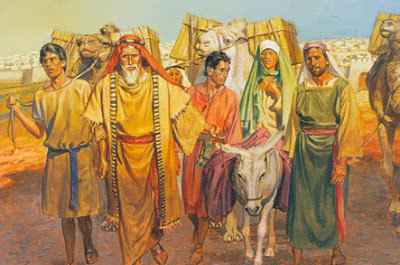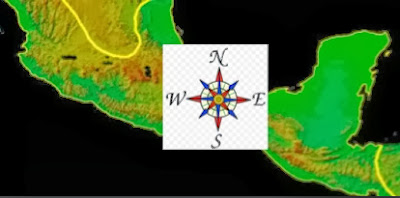Continuing from the
last post about why Ishmael followed Lehi into the wilderness and more about
Nephi’s sisters.
In the last post, about
the father’s control over his family and even grown sons and their wives, reveals
some interesting dimensions in Lehi’s relationship with his rebellious older
sons Laman and Lemuel, we covered the authority of Hebrew fathers in the time
of Lehi. However, some ask that if Lehi had the paternal authority to kill his
rebellious sons, why did he let them live, or at least not threaten them when
they continued with such rebellious actions? Obviously, under Hebrew law, Laman
and Lemuel were worthy of punishment for their treatment and disregard for
their father, even seeking to kill him (1 Nephi 17:44).There seems little doubt that Lehi, if he wanted to be severe in his treatment of his sons, had the right and authority to do so. What Lehi might have done under such circumstances earlier in his life, before being called to be a prophet, and then to head into the wilderness with a promise of a future land for he and his posterity, is unknown, but no doubt these latter events in his life brought out a more loving nature had he ever been of such punishing nature earlier.
Then, too, through the visions and revelations he had been given, Lehi knew that Laman and Lemuel and their posterity had important long-term roles to play in the Lord’s plans, just as did Nephi and Sam. Rather than punishing, or disinheriting these sons, Lehi showed forth his love, patience and long-suffering and “did exhort them then with all the feeling of a tender parent, that they would hearken to his words, that perhaps the Lord would be merciful to them, and not cast them off” (1 Nephi 8:37). No doubt, Lehi was in hopes, even though his vision showed him otherwise, that Laman and Lemuel would repent and remain in the fold. One of the many things we can learn from Lehi is that of his tender feelings to his family and completely forgiving nature—something that many of those of his time in Israel did not possess. But what of the daughters Laman and Lemuel married, what of their rebellion?
Under Hebrew law of the time, Lehi well understood that it was the duty of each person to take and be taken in marriage, and it was the obligation of parents to see that their children were married, and to the right person. As Jeremiah put it, “take ye wives, and beget sons and daughters; and take wives for your sons, and give your daughters to husbands” (Jeremiah 29:6). Israel was definitely a family-oriented culture and nation, with parental duty evidenced reflected in numerous scriptural passages.
In addition, Lehi’s love for his sons and daughters-in-law would have been fused through Hebrew and Jewish practices and the rules that surrounded marriage. Obviously, the ancient Israelites had a patriarchal family structure. In some ways, the status of women was low—they were regarded as the property of their fathers or husbands and could do nothing without their consent. And as has been pointed out, the father in ancient Israel controlled who his sons and daughters married, with usually the patriarch selecting a bride for his son and who paid a "bride price" to her father. The acceptance of this bride price constituted a legally binding betrothal, which was followed by some wedding celebration when the bride took up residence with her new family. Most marriages, therefore, were arranged. Moreover, the wife usually had fewer rights than her husband and was expected to be subservient to him.
To a considerable extent, marriage was also an economic arrangement. There was little room for romantic love, and even simple affection was not considered essential. Procreation and cooperation were the main marital duties. Also of concern was the perpetuation of a man's name, which brought about levirate (a man's obligatory marriage to his brother's widow). This kind of marriage was at times required (Deuteronomy 25:5) and at other times prohibited (Leviticus 20:21). Every healthy person was expected to marry, and single men and women were often reviled and shunned. While a man could have several wives and concubines, divorce was permitted if a man found some "uncleanness" in his wife. In such a case, he simply wrote her a bill of divorce and sent her out of his house (Deuteronomy 24:1); however, it was virtually impossible for a wife to divorce her husband.
Lehi acted in accordance with these general principles. He would have largely controlled whom his sons and daughters married. Through him came the commandments of the Lord that “his sons should take daughters to wife” and that they should return to Jerusalem to get Ishmael and his family for this very purpose (1 Nephi 7:1–2). As far as we know, no objections were raised by Lehi’s sons, nor were their preferences consulted. Furthermore, it is said that by seeing his sons married, Lehi “fulfilled all of the commandments of the Lord which had been given unto him” (1 Nephi 16:8). Thus, Lehi’s own obedience to the Lord included the duty of seeing that his sons were married. The fact that Lehi selected the family whose daughters his sons would marry gave an additional element to his relationship with all his posterity—bonded by the fact that Lehi was responsible for their marriages.
Its should also be kept in mind that at the time of Lehi, there were no possibilities for a woman to earn a living, and no place she could go without a father, a husband, or older male guardian to “protect her.” However, being betrothed under Jewish law of the time was far more serious than engagements in our day and about the same as being married today except for the consummation. This event of the daughters aligning themselves with Lehi’s sons is significant under the circumstances and should suggest that a prior alignment had been arranged, no doubt by their parents, which led Lehi, and his sons, to believe that Ishmael would follow Lehi into the wilderness. There certainly seems no question in Lehi, Nephi, or his brothers about going and getting Ishmael (1 Nephi 7:1-2). Obviously, there was no complaint on the part of Laman and Lemuel to travel another two weeks up to Ishmael’s home, nor do we find any resistance on the part of Ishmael to go into the wilderness with Nephi and his brothers (1 Nephi 7:3-6).
The only “odd-man-out” arrangement was Ishmael’s oldest daughter. But obviously, the Lord had a plan, and the inclusion of Zoram in that plan settled the problem of the oldest daughter finding a husband for the journey to the Land of Promise. It should also be kept in mind, that though a woman was brought into the house of her husband's family upon marriage, she remained somewhat of an outsider for the remainder of her life. It was, therefore, also desirable for her to marry into a household that was related by blood. For this reason, cross-cousin marriages were a time-honored Israelite tradition. This seems to be the case with Lehi’s and Ismael’s children, since at least Hugh Nibley has suggested they were related when he said, “it has ever been the custom among the desert people for a man to marry the daughter of his paternal uncle." That Lehi and Ishmael were somehow kinfolks indeed seems likely, but what that relationship was is not clear.
(See the next post,
“Why Did Ishmael Follow Lehi into the Desert? Part IV,” for the continuing
discussion of not only why Ishmael followed Lehi into the wilderness, but who
the sisters of Nephi were and how they fit into Lehi’s family)





































